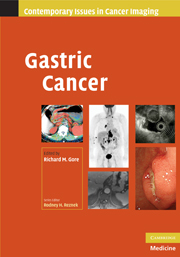Book contents
- Frontmatter
- Contents
- List of contributors
- Series Foreword
- Preface to Gastric Cancer
- 1 Epidemiology of gastric cancer
- 2 Pathology of gastric cancer
- 3 Endoscopy in the diagnosis and treatment of gastric cancer
- 4 Upper gastrointestinal series in the diagnosis of gastric cancer
- 5 Surgical management of gastric cancer
- 6 Systemic therapy for gastric cancer
- 7 MDCT, EUS, PET/CT, and MRI in the management of patients with gastric neoplasms
- 8 Gastric cancer: current trends and future opportunities
- Index
- References
7 - MDCT, EUS, PET/CT, and MRI in the management of patients with gastric neoplasms
Published online by Cambridge University Press: 31 March 2010
- Frontmatter
- Contents
- List of contributors
- Series Foreword
- Preface to Gastric Cancer
- 1 Epidemiology of gastric cancer
- 2 Pathology of gastric cancer
- 3 Endoscopy in the diagnosis and treatment of gastric cancer
- 4 Upper gastrointestinal series in the diagnosis of gastric cancer
- 5 Surgical management of gastric cancer
- 6 Systemic therapy for gastric cancer
- 7 MDCT, EUS, PET/CT, and MRI in the management of patients with gastric neoplasms
- 8 Gastric cancer: current trends and future opportunities
- Index
- References
Summary
Adenocarcinoma of the stomach
Introduction
Since the late 1990s, the treatment of gastric cancer has become increasingly sophisticated with therapeutic options ranging from endoscopic mucosal resection (EMR) and endoscopic submucosal dissection (ESD) for selected mucosal (see Chapter 3) early gastric cancer (EGC) to more radical gastrectomy and lymph node dissection (see Chapter 5) for advanced gastric cancer (AGC). Accordingly, accurate preoperative staging, particularly with respect to the depth of mural invasion, adjacent organ invasion, and nodal involvement, is key to selecting the most suitable therapy and avoiding inappropriate attempts at curative surgery.
Although upper gastrointestinal (GI) endoscopy and double-contrast upper GI series are the primary means of diagnosing gastric cancer and are excellent in depicting the precise location of the tumor, they cannot determine the depth of mural invasion or the presence of local, regional, or distant metastases. Recent advances in multidetector computed tomography (MDCT), endoscopic ultrasound (EUS), magnetic resonance (MR) imaging, and positron emission tomography-computed tomography (PET-CT) have dramatically improved the accuracy of preoperative staging of patients with gastric cancer and have provided a more accurate means of assessing tumor response to therapy and detecting recurrent disease.
- Type
- Chapter
- Information
- Gastric Cancer , pp. 120 - 194Publisher: Cambridge University PressPrint publication year: 2009

